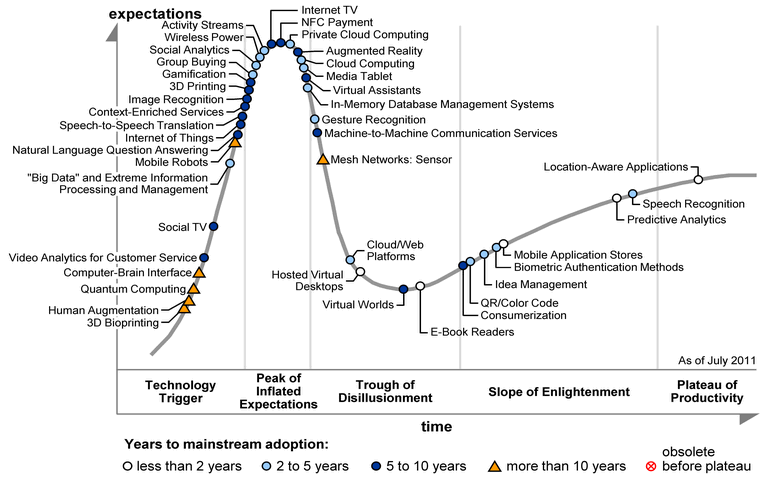Recently I became exposed to an interesting idea called the Gartner Hype Cycle. It’s implications might be useful to those of us still interested in the future viability of virtual worlds and MMOs.
The Gartner Hype Cycle is a graphic that depicts public expectations of new and emerging (often not so new) technologies in the form of a graph. It is updated annually and produced by a research and advisory company called Gartner, Inc.
The best way to describe it is from this promotional text from the Mastering the Hype Cycle: How to Choose the Right Innovation at the Right Time (Gartner) for sale at Amazon:
It happens over and over again. Some innovation (a new product, a management trend) comes along that captures the public’s imagination. Everybody joins the parade with great fanfare and high expectations. This “next big thing” promises to transform the companies that adopt it — and inflict great peril on those that don’t.
Then, when the innovation fails to deliver as promised immediately, everyone starts bailing out. Investments are wasted; stock prices plunge; disillusionment sets in.
Here’s a video produced by Gartner, Inc. that explains the cycle in more detail:
[yframe url=’http://www.youtube.com/watch?v=tlZSUkFIv4c’]
The hype cycle is used primarily by companies and investors to determine whether to invest in a particular technology. It also has some predictive value as well.
Gartner Hype Cycle 2011 Results
The latest graphic was released in 2011 and readers of my blog might be interested to know that the Gartner Group has been tracking virtual worlds since 2007 when they made their debut on the cycle graph. Of additional interest to video game developers, Gartner has also been tracking the gamification trend that has been all the rage in the past few years.
However, the fact that virtual worlds are current at the very bottom of the trough of disillusionment is cause for concern. Needless to say, if there was one word to describe how many of us feel about virtual worlds and MMOs the word disillusionment fits the bill perfectly. More on this later…
I don’t want to bog down this article by having to explain all the aspects of the Gartner hype cycle but a brief explanation is necessary.
The hype cycle graph is broken down into 5 phases:
Technology Trigger: A potential technology breakthrough kicks things off. Early proof-of-concept stories and media interest trigger significant publicity. Often no usable products exist and commercial viability is unproven.
Peak of Inflated Expectations: Early publicity produces a number of success stories—often accompanied by scores of failures. Some companies take action; many do not.
Trough of Disillusionment: Interest wanes as experiments and implementations fail to deliver. Producers of the technology shake out or fail. Investments continue only if the surviving providers improve their products to the satisfaction of early adopters.
Slope of Enlightenment: More instances of how the technology can benefit the enterprise start to crystallize and become more widely understood. Second- and third-generation products appear from technology providers. More enterprises fund pilots; conservative companies remain cautious.
Plateau of Productivity: Mainstream adoption starts to take off. Criteria for assessing provider viability are more clearly defined. The technology’s broad market applicability and relevance are clearly paying off.
How Does Gartner Arrive at Its Conclusions?
Gartner claims to be a worldwide leader in evaluating new technologies with over 650 analysts around the world using proprietary research processes. There have been some valid criticisms leveled at the hype cycle:
There have been numerous criticisms of the hype cycle, one of which is that it is not a cycle, and that all technologies don’t really have the same outcome. Another criticism is that the shape of the line has not altered or accelerated in ten years, even though all the evidence suggests that the half-life of new technologies is getting shorter, and the number of competing technologies is increasing.
Obviously not every technology becomes successful and enters the slope of enlightenment. This goes for virtual worlds and MMOs.
What Do They Mean By “Virtual World”?
As someone who is interested in virtual worlds and MMOs, the first thing I wanted to figure out is what Gartner Group means by virtual world. It’s not exactly clear if they are referring to a virtual world like Second Life or a MMORPG like World of Warcraft. My opinion is that the terms are interchangeable enough to examine the hype curve in more depth.
Karl Kapp in an article dealing with the Gartner Hype Cycle and Virtual Worlds uses the example of Second Life as a virtual world.
We have no way of knowing if they have analyzed MMORPG’s like EverQuest, World of Warcraft, Lord of the Rings Online and others. Certainly there have been a few successful MMOs and many more that have failed. There should be enough MMORPG subscriber data out for Gartner to come up with their own forecast. Until then we can only speculate and look for similarities.
From General to Specific Cases of Virtual Worlds and Where They are Currently on the Hype Cycle
It would be a mistake to assume that every virtual world and MMO is at the same location on the trough of disillusionment. The writer at Beatennetworks makes a good case that by the end of 2007 Second Life already entered the phase that comes directly after the trough of disillusionment: the slope of enlightenment. This is about 4 years earlier than the general position of virtual worlds which ended up in the trough in 2011.
Comparing WoW Subcribers to the Gartner Hype Cycle
Naturally the MMORPG World of Warcraft comes to mind as reference point to test the legitimacy of the cycle. If you look at a graph of WoW subscribers you can see that in July 2007 — when the Gartner hype cycle was released and had placed virtual worlds at the top of the Peak of Inflated Expectations — WoW had 9 million subscribers.
The total number of WoW subscribers reached it’s zenith with 12 million subscribers in 2010. This puts the Gartner Hype Cycle predictions off by 3 years if you consider WoW as the bellwether of virtual worlds.
If we examine the WoW subscriber curve we can see the familiar Gartner Hype Cycle starting to emerge as WoW becomes more unpopular. It may take 2 more years to hit the bottom of the trough.
Factoring WoW in China
However, one problem with using WoW as a standard for MMOs and virtual world popularity is Blizzard’s aggressive expansion into markets such as China and beyond has skewed the results. For many years, the additional subscriber numbers coming from markets like China have allowed Blizzard to give the public and investors the impression that because subscriptions keep growing that WoW is commensurately healthy.
Back in 2010, an investor website concluded that 4 to 6 million WoW subscribers are in China. If you remove Chinese WoW players, that means WoW at its height of popularity only had 6 million actual subscribers. China has a far less lucrative monetization models so it’s hard to compare apples to apples.
What Does this all Mean for MMOs?
Most MMOs and virtual worlds will follow the familiar Gartner Hype Cycle but at different times. This is due to various factors such as when they were released and their penetration of different markets.
Not all technologies and MMOs can escape the trough and graduate into the slope of enlightenment and beyond; many will end failing or just stagger along. A few will enter the slope of enlightenment and graduate into the plateau of productivity. This applies to MMOs and virtual worlds. In the past 14 years, we’ve seen many MMOs come onto the scene with glorious fanfare and fade into the quicksand of obscurity.
We’ve all experienced the sense of anticipation built on hype that is generated from the developers and their cheerleaders in gaming press. Every new MMO is “the next big thing” or “the revolutionary MMO that will shake the foundations of the industry”. Forgive me for being so jaded as to believe any of the marketing-speak anymore.
Hype is Here to Stay
If we examine the Gartner Hype Cycle we can see that hype is indeed a useful and integral part of the lifespan of new products. If investors don’t get excited about a new MMO, they won’t fund it. If new MMOs stop getting funded than Jack and Jill gamer won’t have any more virtual dragons to slay.
Despite it’s bad reputation, hype is a necessary evil in this business. If we can identify it and put it into proper perspective, we won’t be so disheartened when we see start to feel that our latest MMO has somehow stopped being enjoyable to play.
Conclusion
We are all guilty of occasionally indulging in being overly enthusiastic and exuberant. Part of the joy of life is wanting to share our passion — even when it is more hype than substance — with others.
At the end of the day when you subtract the hype quotient from a person, place or thing you end up with the naked reality of its intrinsic value. For the MMO business, the rubber has hit the road in the form of a reality check that given the limitations of technology, the paucity of imagination and will, only so much is possible and probable. Virtual worlds and MMOs are now at this point and some of us have known it for a while now.
Virtual worlds have preoccupied the imagination of writers, dreamers, futurists and yes even gamers for years now. I believe that a sense of fatigue and despair has entered the virtual world zeitgeist. Like a parent that sees his child grow up with hopes of becoming a successful lawyer or doctor eventually fade, we too have seen the expectations of virtual worlds float down to earth to something more mundane and pedestrian. Rarely is there really anything inspirational or transcendent about virtual worlds now as they have morphed into sleight of hand monetization schemes that cater to the lowest common denominator that would make Las Vegas blush.
After years being part of the MMO scene there is a feeling of collective disillusionment among MMO commentators and players. Even independent non-gaming research companies like Gartner know it.
We are at a crossroads. On one side are the Blizzard’s and Zynga’s of this world and on the other side are a handful of MMO companies like ArenaNet, Goblinworks and 38 Studios and others hoping to challenge the status quo with their own vision/hype/reality.
Which road is the industry going to take? Will virtual worlds and MMOs make it out of the trough and survive? If they do, what will they look like and will they be worth being a part of?
-Wolfshead




I think it would be mistake to use WoW’s subscriber base as the only health indicator of the MMO market.
There is a wide range of titles today fighting for gamers attentions and the collective value of those subscriptions and microtransactions is continuing to grow.
Whilst jaded gamers see a new title and thinking “WoW-alike”, “Asian grind-fest” or “MOBO”, there is still considerable investment going into new MMOs and plenty of hype/media publicity.
TL;DR version: Adoption/visibility of Virtual Worlds is growing, not declining.
It would probably help if MMO makers made MMOs that were actually virtual worlds, rather than really big multiplayer levels where a line of 300 guys goes to find the same silver necklace for the same old lady and get the same Byzlithian Shield of Everlasting Cupcakes, and where clans – err, sorry, guilds – go out to play a slightly more grandiose version of multiplayer co-op Quake, waiting patiently for the same monster to respawn in the same place at the same interval, over and over and over…
Ultima Online got it at least partially right, with users able to build things, beasts that could actually travel around and had life cycles, and so forth. Until MMOs start acting less like self-cleaning ovens and more like, well, virtual worlds, people are going to keep wondering what the big deal is.
Here’s my thing: I want an MMO in which I can go into a big forest and cut my initials into a tree. And I want to be able to come back a year later, and see my initials still in the tree – but two inches higher.
Oh, and I also want one that doesn’t involve either space trade with the Triak Sector and its attendant 4,205 kinds of starship upgrade – and in which you play for 290 hours without seeing a soul and are then instantly and unceremoniously vaporized by the first person you come across – or that involve a quest for the Gleaming Sword of Myrithial, the shining blade of the Elf King Elrond Hubbard, who offended the Morlish Were-Dwarves of Dumbkeep by slaying the Hellbeast Gorgoranth the Uglificent.
Seriously, people – imagination, motherf*cker, do you speak it?